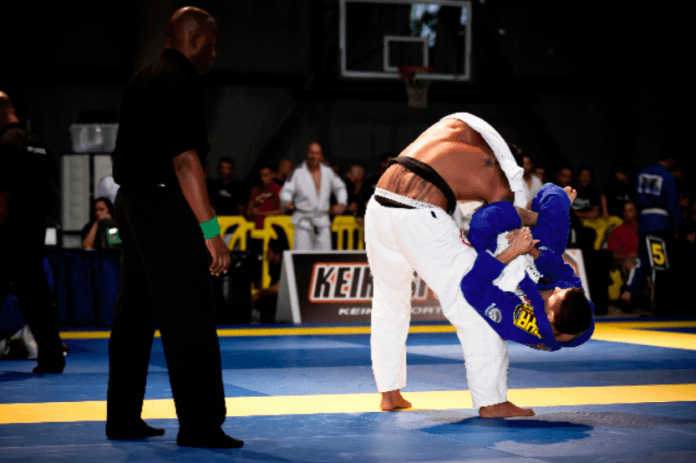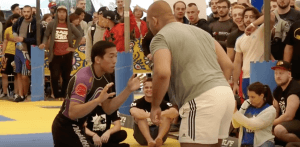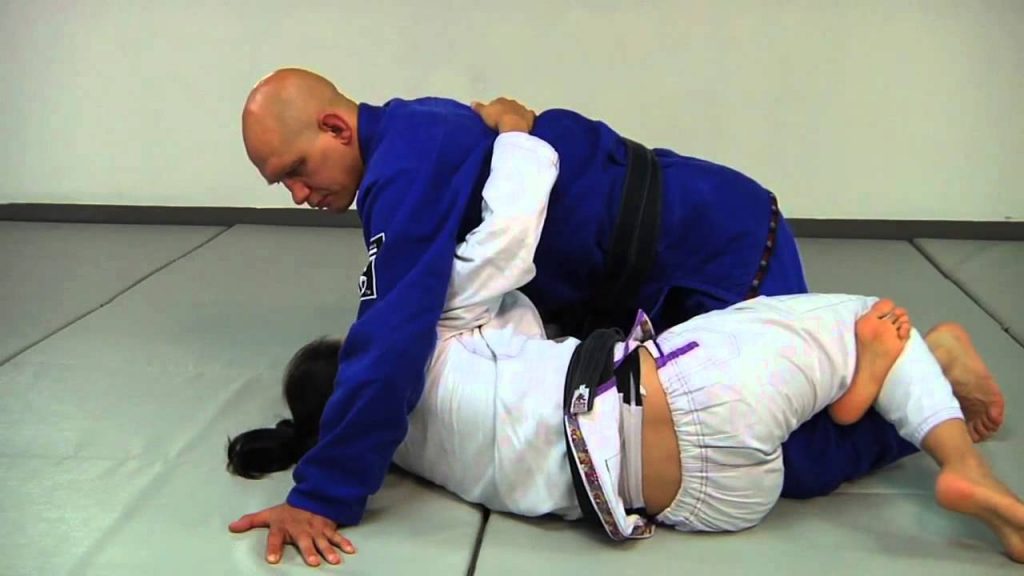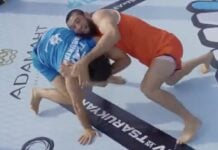
“Use his strength against them!” How often do you hear this in relation to martial arts? From Aikido to Brazilian Jiu-Jitsu, the principle behind martial arts seems to be quite simple. Just use the opponent’s strength against them and you’ll be fine. The stronger they are the better for you, if we were to believe this approach. But is it really so easy to just handle a resisting opponent? Anyone who trains grappling martial arts can easily tell you the right answer to this question. For those who live n a Steven Seagal movie, the answer is NO! Dealing with a resisting opponent is a difficult task at any given time. When you’re up against bigger opponents in BJJ, though, things get a whole new meaning.
When you have somebody lying on top of you on the ground, you’re not going to have much fun. Add to that a dominant position and grappling knowledge and you might be stuck for a while. In case of bigger opponents in BJJ, the weight itself is more than enough to have you gasping for air. Unless you use the correct strategies of course. So let’s go over some of the best things you can do to make sure you survive such an encounter. And remember that while it is not as easy as in a Seagal movie, dealing with bigger opponents in BJJ is not really very hard. Unlike the opening sentence of this article, the BJJ approach is all about the right leverage.
Eddie Bravo Against A Bigger Opponent
Benefits Of Training With Different Partners
First of all, when training Jiu-Jitsu and/or other grappling martial arts it is always a good idea to train with different partners. Well, almost always. If you are injured, you should definitely stay away from the ultra-heavyweights in the gym. Most BJJ academies have members that represent all shapes and sizes of the human body. Training with different sized opponents is just as important as training with different ranked ones. Training with bigger training partners should be a regular occurrence.
The experience you gain from training with bigger opponents in BJJ is priceless. Although you might not encounter anyone bigger than you in competition, you most certainly need the training lessons. That said, training and competition are two very different situations. Preparing to face a bigger opponent in both of them needs to be approached accordingly
-
In Training
When training, look to roll with larger training partners every time you step on the mat. Yes, it is going to suck. However, it is also going to teach you very important things about your Jiu-Jitsu game. Although it is not limited to them, there are two major benefits of regularly training with bigger opponents in BJJ. First, you’ll discover what doesn’t work. Figuring this out is much more important than knowing what works. Against a bigger opponent in BJJ, lots of your go-to moves that work on people your size are going to be ineffective. The size and weight change the leverage points of moves, and certain techniques are just not a good fit.

-
In Competition
At a tournament, things are quite a bit different. In essence, strength is still not going to work and technique is. You’ll still need the correct leverage, but the intensity is way different than in training. Now, make sure you think long and hard about signing up for the absolute division at a tournament. If you compete in the two lowest weight classes you might want to skip it. If you decide to make history though, your technique is going to need two more things. First, you’ll have to know exactly how to counter the fact that the opponent is significantly heavier. Secondly, you’ll have to learn patience. Accept that you’re going to end up on the bottom and be patient with your setups and timing.
Strategies To Defeat Bigger Opponents In BJJ
Now that the basic approach is clear, let’s look at a few strategies that are going to make you a BJJ giant killer. They’re all rooted in the basic principles that we covered above. You’ll need to use correct leverage, perfect technique and avoid carrying the added weight. In those terms, there are a few key strategies for ending up with a victory over bigger opponents in BJJ.
1. Stay dynamic
The first thing you need to do when facing bigger opponents in BJJ is to keep moving. If you stop while the opponent is on top, you’re most likely going to get stuck. The only time you can stop is when you have a system of levers and frames already in place. If you stop when your opponent wants you to, you’re going to be forced to carry all their weight. This is effectively going to kill your game before you even have an opportunity to set it up. SO stay active until you have everything ready to attack.
2. Technique Vs. Strength
Arguably, the most important factor when dealing with bigger stronger grapplers is technique. BJJ is historically built on the notion that smaller people can defeat bigger ones. To that effect, leverage is the basic principle behind the sport. Staying technical when you’re at a weight disadvantage means you can flip the odds without struggling. BJJ techniques require an insane amount of details but once you get it right, there’s no stopping them. Go with strength against strength and you’ll surely lose.
3. Grip Fighting
In BJJ, grips are the best way of controlling your opponent. However, relying on grip strength does not equate to efficient grip fighting. You’re never going to control a bigger opponent in BJJ without strategic grip knowledge. That said, grappling with the Gi helps immensely. The Gi provides multiple anchor points that can really hold an opponent in place. Grips at the end of the pants or behind the triceps are perfect for controlling stronger grapplers. Playing with the lapel can also help you keep your large opponent at a distance.
4. Dominant Positioning
In terms of positions, certain ones are out of the question against bigger opponents in BJJ. One such position is bottom side control. No matter how good you are at escaping, once your opponent pins you, it’s over. Furthermore, some of the most dominant positions, like the mount can be very hard to maintain. In most cases, your opponent is going to be able to just bench-press you off. With that in mind, apart from a few effective guard strategies, two major positions stand out for giant-killing. One is the back, which brings many points and is easy to control, although submissions might come harder. The other is the Ashi Garami, especially closed circuits, where submissions are plentiful but there are no points.
5. Guard Strategies
Playing guard against bigger opponents in BJJ means playing with distance. Once your opponent is close to you, they can apply pressure to dismantle your defenses. Guards that work against larger people are large distance ones and immediate proximity ones.
When fighting from a distance, your best bet against a larger opponent is guards like the Spider guard, De La Riva guard or any other lapel guard. The basic idea is to keep your opponent eat a distance so you neutralize their weight advantage. Another good strategy is going for guards that place you directly underneath your opponent’s base. These are certain half guard variations, the X-guard, and the butterfly guard.
6. Smart Passing Sequences
Attempting pressure passes is the best way to end up on the ground against a bigger opponent in BJJ. As effective as pressure passes are, they have their limitations. When you’re up against someone bigger, look to employ the first strategy. Stay dynamic and keep moving. Passing a stronger grappler’s guard can be difficult unless you make them shift their weight by themselves. The leg drag is a perfect example. You isolate one leg and focus on making your opponent shift to the side. Once you have them you can get into position and easily take their back.
7. From The Feet
When standing against a larger foe, you won’t get a better advice than to pull guard. Yes, you know takedowns, yes you wrestled in high school. When your opponent is twice your size, and also knows grappling, it is not smart to shoot for a double. A 200+ lbs. opponent sprawled on top of you is not fun. Pulling guard is the safest and smartest strategy. Once down. Go for any of the guard strategies we discussed above.


![Darce Choke Encyclopedia – Origins, Mechanics and Variations [2025] BJJ, choke, Brabo, BJJ Darce Choke, D'arce Choke, Darce BJJ Choke](https://bjj-world.com/wp-content/uploads/2017/11/JungPoirierLeeYahoo-218x150.jpg)















![Modern Split Squat Passing Jason Rau DVD Review [2024] Modern Split Squat Passing Jason Rau DVD Review](https://bjj-world.com/wp-content/uploads/2024/11/modern-split-squat-passing-jason-rau-dvd-review-100x70.png)


![Back Hacks Yigit Haney BJJ DVD Review [2025] Back Hacks Yigit Haney BJJ DVD Review](https://bjj-world.com/wp-content/uploads/2024/12/back-hacks-yigit-haney-bjj-dvd-review-100x70.png)
![The Whole Omoplata Enchilada Lyanne Perez DVD Review [2024] The Whole Omoplata Enchilada Lyanne Perez DVD Review](https://bjj-world.com/wp-content/uploads/2024/11/whole-omoplata-enchilada-lyanne-perez-dvd-review-100x70.png)

![Special K Guard Neil Melanson DVD Review [2025] Special K Guard Neil Melanson DVD Review](https://bjj-world.com/wp-content/uploads/2025/03/special-k-guard-neil-melanson-dvd-review-100x70.png)
![Roger Gracie Guard Passing System DVD Review [2025] Roger Gracie Guard Passing System DVD Review](https://bjj-world.com/wp-content/uploads/2025/02/roger-gracie-guard-passing-system-dvd-review-100x70.png)

![BJJ Foundations Mikey Musumeci DVD Bundle Review [2024] BJJ Foundations Mikey Musumeci DVD Bundle Review](https://bjj-world.com/wp-content/uploads/2024/09/bjj-foundations-mikey-musumeci-dvd-bundle-review-100x70.png)
![Assassin Choke Baret Yoshida DVD Review [2024] Assassin Choke Baret Yoshida DVD Review](https://bjj-world.com/wp-content/uploads/2024/10/assassin-choke-baret-yoshida-dvd-review-100x70.png)


![Front Headlock and Turtle Escapes Brian Glick DVD Review [2024] Front Headlock and Turtle Escapes Brian Glick DVD Review](https://bjj-world.com/wp-content/uploads/2024/11/headlock-and-turtle-escapes-brian-glick-dvd-review-100x70.png)

![Tricks for Unstoppable Takedowns Georges St Pierre DVD Review [2024] Tricks for Unstoppable Takedowns Georges St Pierre DVD Review](https://bjj-world.com/wp-content/uploads/2024/12/unstoppable-takedowns-georges-st-pierre-dvd-review-100x70.png)










![Shoulder Lock Mastery Zach Green DVD Review [2025] Shoulder Lock Mastery Zach Green DVD Review](https://bjj-world.com/wp-content/uploads/2024/12/shoulder-lock-mastery-zach-green-dvd-review-100x70.png)

![Two Sides One Game Sweep and Pass Marcos Tinoco DVD Review [2024] Two Sides One Game Sweep and Pass Marcos Tinoco DVD Review](https://bjj-world.com/wp-content/uploads/2024/11/sweep-and-pass-marcos-tinoco-dvd-review-100x70.png)